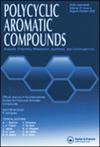Synthesis, Characterization, Theoretical Studies and in Vitro Embriyotoxic, Genotoxic and Anticancer Effects of Novel Phenyl(1,4,6-Triphenyl-2-Thioxo-1,2,3,4-Tetrahydropyrimidin-5-yl)Methanone
IF 2.4
3区 化学
Q2 CHEMISTRY, ORGANIC
引用次数: 0
Abstract
In this study, phenyl (1,4,6-triphenyl-2-thioxo-1,2,3,4-tetrahydropyrimidin-5-yl)methanone was obtained by using the Biginelli reaction method. The structure of this compound was analyzed using elemental analysis, IR, 1H, and 13C NMR. The quantum chemical calculations (QCC) of this compound were performed density functional theory (DFT) method, 6–31 G (d, p) base set, and B3LYP functions with the Gaussian09W software package. Literature shows that pyrimidine-derived compounds have very active biological properties. For this reason, the biologically active properties of the synthesized compound were also examined. To determine embryotoxic, genotoxic, and cytotoxic effects of compound, 3-(4,5-dimethylthiazol-2-yl)-2,5-diphenyl-2H-tetrazolium bromide (MTT), lactate dehydrogenase (LDH) release, micronucleus (MN) and 8-OH-dG assays were carried out. On the other hand, pharmacokinetic and toxicity properties (ADMET) were predicted in silico via SwissADME and Protox-II web tools. In silico estimates of this compound used in the study showed that the compound has the covetable physicochemical properties for bioavailability. In conclusion, the obtained results of our study clearly showed that this compound exerted strong toxicity potential.
新型苯基(1,4,6-三苯基-2-硫酮-1,2,3,4-四氢嘧啶-5-基)甲酮的合成、表征、理论研究以及体外胚胎毒性、基因毒性和抗癌作用
本研究采用 Biginelli 反应法获得了苯基(1,4,6-三苯基-2-硫酮-1,2,3,4-四氢嘧啶-5-基)甲酮。利用元素分析、红外光谱、1H 和 13C NMR 分析了该化合物的结构。该化合物的量子化学计算采用了密度泛函理论(DFT)方法、6-31 G (d, p) 基集和 B3LYP 函数,软件包为 Gaussian09W。文献显示,嘧啶衍生化合物具有非常活跃的生物特性。因此,我们也对合成化合物的生物活性特性进行了研究。为了确定化合物的胚胎毒性、基因毒性和细胞毒性作用,研究人员进行了 3-(4,5-二甲基噻唑-2-基)-2,5-二苯基-2H-溴化四氮唑(MTT)、乳酸脱氢酶(LDH)释放、微核(MN)和 8-OH-dG 检测。另一方面,通过 SwissADME 和 Protox-II 网络工具对药物代谢动力学和毒性特性(ADMET)进行了硅学预测。对研究中使用的这种化合物进行的硅学估算表明,该化合物具有生物利用度所需的理化特性。总之,我们的研究结果清楚地表明,该化合物具有很强的毒性潜力。
本文章由计算机程序翻译,如有差异,请以英文原文为准。
求助全文
约1分钟内获得全文
求助全文
来源期刊

Polycyclic Aromatic Compounds
化学-有机化学
CiteScore
3.70
自引率
20.80%
发文量
412
审稿时长
3 months
期刊介绍:
The purpose of Polycyclic Aromatic Compounds is to provide an international and interdisciplinary forum for all aspects of research related to polycyclic aromatic compounds (PAC). Topics range from fundamental research in chemistry (including synthetic and theoretical chemistry) and physics (including astrophysics), as well as thermodynamics, spectroscopy, analytical methods, and biology to applied studies in environmental science, biochemistry, toxicology, and industry. Polycyclic Aromatic Compounds has an outstanding Editorial Board and offers a rapid and efficient peer review process, as well as a flexible open access policy.
 求助内容:
求助内容: 应助结果提醒方式:
应助结果提醒方式:


